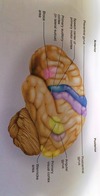Lab 10 and Chapter 14: Brain and Cranial Nerves Flashcards
(54 cards)
What do the various lobes of the brain do?
Frontal lobe: motor cortex (voluntary movement of skeletal muscle)
Occipital lobe: visual
Temporal: auditory and olfactory
Parietal: somatosensory (general senses-touch,pain, pressure, tempature)
Insula lobe: gustation

What is the white matter and the gray matter in the cerebral hemispheres?
White matter: tracts that connect the two hemispheres (corpus callosum)
- deep to cortical gray matter (opposite to spinal cord)
- Composed of tracts (bundles of axons) that connect one part of brain to another and to spinal cord
Gray matter: cell bodies (soma), dendrites, synapses, and unmyelinated fibers for decisions, memory, and sensation (and analysis of sensation)
- form cortex of cerebrum and cerebellum
- forms basal nuclei
- found in limbic system
What are the 6 main parts of the brain?
- Cerebrum
- conscious thinking
- Corpus Callosum
- white matter that connects the two cerebral hemispheres
- Cerebral cortex
- outer layer of the cerebrum
- Diencephalon
- Thalamus
- Hypothalamus
- Epithalamus (pineal gland)
- Optic chiasma
- Brain Stem
- midbrain
- pons
- medulla oblongata
- Cerebellum
- cerebral cortex (gray matter)
- arbor vitae (branched white matter)
What are the functions of the parts of the diencephalon?
- thalamus
- gateway to cerebral cortex
- fluid filled space between the two halves = 3rd ventricle
- hypothalamus
- connects to pituitary gland by infundibulum
- Autonomic control center: includes thirst, hunger, satiety centers and temperature regulator
- epithalamus /pineal gland
- secretes melatonin
- optic chiasma
- where cranial nerve II (optic nerve) crosses
What is the function of the medulla oblongata?
- includes the respiratory center (for breathing)
- and cardiovascular center (for HR and blood pressure)
Where is the olfactory nerve and what does it do?
Number I
Smell (sensory only)
Travels through ethmoid and cribriform plate
Where is the optic nerve and what does it do?
Number II
Vision
Sphenoid bone, optic canal
Where is the oculomotor nerve and what does it do?
NUmber III
Movement of eyeball
Superior orbital fissure (sphenoid bone)
Medial rectus, superior rectus, inferior rectus, inferior oblique muscles
What is the trochlear nerve and what does it do?
Number IV
Movement of eyeball
Sphenoid bone, superior orbital fissure
Superior oblique muscle
Where is the trigeminal nerve and what does it do?
Number V
Sensations of the face, chewing
Masseter, temporalis
Where is the abducens nerve and what does it do?
Number VI
Movement of eyeball (laterally)
Superior orbital fissure (sphenoid bone)
Lateral rectus
Where is the facial nerve and what does it do?
Number VII
Facial expression;taste
Frontalis, occipitalis, orbicularis oculi, obicularis oris, levator labii superioris, depressor labii inferioris, zygomaticus, risorius, mentalis, buccinator
Where is the vestibulocochlear nerve and what does it do?
Number VIII
equilirbrium; hearing
Where is the glossopharyngeal nerve and what does it do?
Number IX
Taste, movement of pharynx during swallowing and speech, secretion of saliva
Where is the vagus nerve and what does it do?
Number X
Taste, swallowing, coughing, parasympathetic stimulation of the heart and digestive tract
Where is the accessory (spinal) nerve and what does it do?
Number XI
Swallowing, movement of head and shoulders
Sternocleidomastoid; trapezius
Where is the hypoglossal nerve and what does it do?
Number XII
Movement of tongue during speech and swallowing
Genioglossus
What do the terms rostral and caudal mean?
Rostral: toward the forehead
Caudal: toward the spinal cord
What are the major components of the cerebrum?
- 83% of brain volume
- Longtudinal fissure: deep groove that separates cerebral hemispheres
- Gyri: thick folds
- Sulci: shallow grooves
- Corpus callosum: white matter that connects the hemispheres
What are the major landmarks of the cerebellum?
- Also has gryi, sulci, and fissures
- 10% of brain volume
- over 50% of brain neurons
What are the components of the cranial dura mater?
- 2 layers
- outer periosteal
- inner meningeal
- layers separated by dural sinuses (collect blood circulating through brain)
- No epidural space in cranium
- Extensions of dura mater
- falx cerebri separates two cerebral hemispheres
- Tentorium cerebelli separates cerebrum from cerebellum
- Falx cerebelli separates right and left halves of cerebellum
WHat is meningitis?
- Inflammation of the meninges
- Serious disease of infancy and childhood (3 mo-2 years especially)
- Caused by bacterial or viral infection of CNS by way of nose and throat
What are the ventricles of the brain?
- Four internal chambers in the brain
- Two lateral ventricles: one in each cerebral hemisphere
- Interventricular foramen connects to 3rd ventricle
- Third ventricle is narrow medial space below corpus callosum
- Cerebral aqueduct runs through midbrain and connects third to 4th ventricle
- Fourth ventrilce is in chamber between pons and cerebellum
- connects to central canal that runs through spinal cord

What is choroid plexus? How do they relate to Ependyma?
- mass of blood capillaries on the floor of each ventricle
- Ependyma–neuroglia that line ventricles and cover chloroid plexus
- produces CSF




